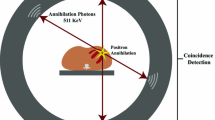Abstract
Evaluation of myocardial perfusion is sometimes necessary in children with congenital heart disease or acquired coronary artery abnormalities. Limited information is available regarding the clinical utility of myocardial perfusion imaging in children. PET imaging with rubidium-82 may provide a convenient clinical means of assessing regional circulatory compromise in pediatric patients with small hearts, due to its improved spatial resolution. Clinically indicated cardiac PET studies obtained in 22 pediatric patients were reviewed by two blinded observers and assigned myocardial perfusion scores using a standard 17-segment model. PET results were correlated with coronary angiography, available in 15 cases, to determine the accuracy of PET scanning for evaluating compromise of the myocardial circulation. Reversible defects consistent with myocardial ischemia were present in 6 of 15 (40%) PET cases. The sensitivity and specificity of cardiac PET for the detection of significant coronary artery disease were 100% and 82%, respectively. The positive predictive value of cardiac PET was 67%, while the negative predictive value was 100%. Cardiac PET imaging with rubidium-82 appears promising for the noninvasive assessment of myocardial perfusion in the pediatric population. The findings from this small series suggest that prospective study in a larger patient cohort merits consideration.



Similar content being viewed by others
Abbreviations
- PET:
-
Positron emission tomography
- VSD:
-
Ventricular septal defect
- SPECT:
-
Single photon emission computed tomography
- EKG:
-
Electrocardiogram
- BMI:
-
Body mass index
- AS:
-
Aortic stenosis
- LAD:
-
Left anterior descending artery
- CX:
-
Circumflex artery
- RCA:
-
Right coronary artery
References
Bengel FM, Hauser M, Duvernoy CS et al (1998) Myocardial blood flow and coronary flow reserve late after anatomical correction of transposition of the great arteries. J Am Coll Cardiol 32:1955–1961
Brunken RC, Perloff JK, Czernin J et al (2005) Myocardial perfusion reserve in adults with cyanotic congenital heart disease. Am J Physiol Heart Circ Physiol 289:H1798–H1806
Chhatriwalla AK, Younoszai A, Latson L, Jaber WA (2006) An 8-month-old girl with an anomalous left coronary artery from the pulmonary artery complicated by myocardial ischemia after surgical reimplantation. J Nucl Cardiol 13:432–436
Hernandez-Pampaloni N (2006) Cardiovascular applications. In: Charron M (ed) Practical pediatric PET imaging. Springer, New York, pp 407–427
Hernandez-Pampaloni M, Allada V, Fishbein MC, Schelbert HR (2003) Myocardial perfusion and viability by positron emission tomography in infants and children with coronary abnormalities: correlation with echocardiography, coronary angiography, and histopathology. J Am Coll Cardiol 41:618–626
ICRP Committee 2 (1987) Radiation dose to patients from radiopharmaceuticals. A report of a Task Group of Committee 2 of the International Commission on Radiological Protection. Ann ICRP 18:1–377
Kondo C, Hiroe M, Nakanishi T, Takao A (1989) Detection of coronary artery stenosis in children with Kawasaki disease. Usefulness of pharmacologic stress 201Tl myocardial tomography. Circulation 80:615–624
Machac J (2006) Gated positron emission tomography for the assessment of myocardial perfusion and function. In: Germano G, Berman DS (eds) Clinical gated cardiac SPECT, 2nd edn. Blackwell Futura, Malden, MA, 294 pp
Machac J, Bacharach SL, Bateman TM et al (2006) Positron emission tomography myocardial perfusion and glucose metabolism imaging. J Nucl Cardiol 13:e121–e151
Treves ST, Blume ED, Armsby L et al (1995) Cardiovascular system. In: Treves ST (ed) Pediatric nuclear medicine 2nd edn. Springer-Verlag, New York, 128 pp
Author information
Authors and Affiliations
Corresponding author
Rights and permissions
About this article
Cite this article
Chhatriwalla, A.K., Prieto, L.R., Brunken, R.C. et al. Preliminary Data on the Diagnostic Accuracy of Rubidium-82 Cardiac PET Perfusion Imaging for the Evaluation of Ischemia in a Pediatric Population. Pediatr Cardiol 29, 732–738 (2008). https://doi.org/10.1007/s00246-008-9232-1
Received:
Revised:
Accepted:
Published:
Issue Date:
DOI: https://doi.org/10.1007/s00246-008-9232-1




